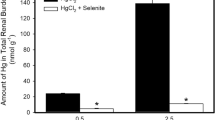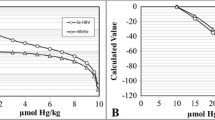Abstract
The influence of dietary selenium (Se) on mercury (Hg) toxicity was studied in weanling male Long Evans rats. Rats were fed AIN-93G-based low-Se torula yeast diets or diets augmented with sodium selenite to attain adequate- or rich-Se levels (0.1, 1.0 or 15 μmol/kg, respectively) These diets were prepared with no added methylmercury (MeHg) or with moderate- or high-MeHg (0.2, 10 or 60 μmol/kg, respectively). Health and weights were monitored weekly. By the end of the 9-week study, MeHg toxicity had impaired growth of rats fed high-MeHg, low-Se diets by approximately 24% (p < 0.05) compared to the controls. Growth of rats fed high-MeHg, adequate-Se diets was impaired by approximately 8% (p < 0.05) relative to their control group, but rats fed high-MeHg, rich-Se diets did not show any growth impairment. Low-MeHg exposure did not affect rat growth at any dietary Se level. Concentrations of Hg in hair and blood reflected dietary MeHg exposure, but Hg toxicity was more directly related to the Hg to Se ratios. Results support the hypothesis that Hg-dependent sequestration of Se is a primary mechanism of Hg toxicity. Therefore, Hg to Se molar ratios provide a more reliable and comprehensive criteria for evaluating risks associated with MeHg exposure.




Similar content being viewed by others
References
Clarkson TW, Magos L (2006) The toxicology of mercury and its chemical compounds. Crit Rev Toxicol 36:609–662
Agency of Toxic Substances and Disease Registry (1999) Toxicological profile for mercury (update). U.S. Department of Health and Human Services, Agency of Toxic Substances and Disease Registry, Atlanta, GA
National Research Council (2000) Toxicological effects of methylmercury. National Academies Press, Washington, DC
Institute of Medicine (2007) Seafood choices: balancing the benefits and risks. In: Nesheim MC, Yaktine AL (eds) National Academies Press, Washington, DC
Parizek J, Pstadalova I (1967) The protective effect of small amounts of selenite in sublimate intoxication. Experientia 23:142–143
Cuvin-Aralar ML, Furness RW (1991) Mercury and selenium interaction: a review. Ecotoxicol Environ Saf 21:348–364
Ganther HE, Goudie C, Sunde ML, Kopecky MJ, Wagner P, Oh SH, Hoekstra WG (1972) Selenium: relation to decreased toxicity of methylmercury added to diets containing tuna. Science 175:1122
Iwata H, Okamoto H, Ohsawa Y (1973) Effect of selenium on methylmercury poisoning. Res Commun Chem Pathol Pharmacol 5:673–680
El-Demerdash FM (2001) Effects of selenium and mercury on the enzymatic activities and lipid peroxidation in brain, liver, and blood of rats. J Environ Sci Health B 36:489–499
Watanabe C, Yin K, Kasanuma Y, Satoh H (1999) In utero exposure to methylmercury and Se deficiency converge on the neurobehavioral outcome in mice. Neurotoxicol Teratol 21:83–88
Suzuki KT, Sasakura C, Yoneda S (1998) Binding sites for the (Hg–Se) complex on selenoprotein P. Biochim Biophys Acta 1429:102–12
Whanger PD (1992) Selenium in the treatment of heavy metal poisoning and chemical carcinogenesis. J Trace Elem Electrolytes Health Dis 6:209–221
Beijer K, Jernelov A (1978) Ecological aspects of mercury–selenium interaction in the marine environment. Environ Health Perspect 25:43–45
Imura N (1986) The role of micronutrient, selenium, in the manifestation of toxicity of heavy metals. Dev Toxicol Environ Sci 12:115–123
El-Begearmi MM, Sunde ML, Ganther HE (1977) A mutual protective effect of mercury and selenium in Japanese quail. Poultry Sci 56(1):313–322
El-Begearmi MM, Ganther HE, Sunde ML (1982) Dietary interaction between methylmercury, selenium, arsenic, and sulfur amino acids in Japanese quail. Poultry Sci 61(2):272–279
Ohi G, Nishigaki S, Seki H, Tamura Y, Maki T (1976) Efficacy of selenium in tuna and selenite in modifying methylmercury intoxication. Environ Res 12:49–58
Stillings BR, Lagally H, Bauersfield P, Soares J (1974) Effect of cysteine, selenium, and fish protein on the toxicity and metabolism of methylmercury in rats. Toxicol Appl Pharmacol 30:243–254
Freidman MA, Eaton LR, Carter WH (1978) Protective effects of freeze dried swordfish on methylmercury content chloride toxicity in rats. Bull Environ Contam Toxicol 19:436–443
Ohi G, Nishigaki S, Seki H, Tamura Y, Maki T, Minowa K, Shimamura Y, Mizoguchi I, Inaba Y, Takizawa Y, Kawanishi Y (1980) The protective potency of marine animal meat against the neurotoxicity of methylmercury: its relationship with the organ distribution of mercury and selenium in the rat. Food Cosmet Toxicol 18:139–145
Magos L (1991) Overview on the protection given by selenium against mercurials. In: Suzuki T, Nobumasa I, Clarkson TW (eds) Advances in mercury toxicology. Plenum, New York, pp 289–298
Ralston CR, Blackwell JL, Ralston NVC (2006) Effects of dietary selenium and mercury on house crickets (Acheta domesticus L.): Implications of environmental coexposures. Environmental Bioindicators 1:98–109
Dyrssen D, Wedborg M (1991) The sulfur–mercury (II) system in natural waters. Water Air Soil Pollut 56:507–519
World Health Organization (1990) Environmental health criteria 101: methylmercury. Geneva International Program on Chemical Safety, World Health Organization
Yang J, Kunito T, Tanabe S, Miyazaki N (2007) Mercury and its relation with selenium in the liver of Dall’s porpoises (Phocoenoides dalli) off the Sanriku coast of Japan. Environ Pollut 148:669–673
Levander OA, Burk RF (1996) Selenium. In: Ekhard E, Ziegler LJ, Filer LJ (eds) Present knowledge in nutrition. International Life Sciences Institute-Nutrition Foundation
Behne D, Pfeifer H, Rothlein D, Kyriakopoulos A (2000) Cellular and subcellular distribution of selenium and selenium-containing proteins in the rat. In: Roussel AM, Favier AE, Anderson RA (eds) Trace elements in man and animals 10. Kluwer Academic/Plenum Publishers, New York, pp 29–34
Hatfield DL (2001) Selenium: its molecular biology and role in human health. Kluwer, Boston, MA
Rayman M (2000) The importance of selenium to human health. Lancet 356:233–241
Schweizer U, Schomburg L, Savaskan NE (2004) The neurobiology of selenium: lessons from transgenic mice. J Nutr 134:707–710
Chen J, Berry MJ (2003) Selenium and selenoproteins in the brain and brain diseases. J Neurochem 86:1–12
Kohrle J, Jakob F, Contempre´ B, Dumont JE (2005) Selenium, the thyroid, and the endocrine system. Endocr Rev 26:944–984
Kyriakopoulos A, Behne D (2002) Selenium-containing proteins in mammals and other forms of life. Rev Physiol Biochem Pharmacol 145:1–46
Bermano G, Nicol F, Dyer JA, Sunde RA, Beckett GJ, Arthur JR, Hesketh JE (1996) Selenoprotein gene expression during selenium-repletion of selenium-deficient rats. Biol Trace Elem Res 51:211–223
Prohaska JR, Ganther HE (1977) Interactions between selenium and methylmercury in rat brain. Chem Biol Interact 16:155–67
Ganther HE (1980) Interactions of vitamin E and selenium with mercury and silver. Ann N Y Acad Sci 355:212–226
Ji X-L, Jin G-W, Cheng J-P, Wang W-H, Lu J, Qu L-Y (2007) Consumption of mercury-contaminated rice induces oxidative stress and free radical aggravation in rats. Biomed Environ Sci 20:84–89
Shi J-W, Feng W-Y, Wang M, Li B, Zhang F, Liu J, Zhao J-J, Chai Z-F (2005) Effects of low dose of inorganic mercury on glutathione antioxidant enzyme system in liver, kidney and brain regions of infant rats after in utero and lactation exposure. Chinese Journal of Pharmacology and Toxicology 19:59–63
Watanabe C (2001) Selenium deficiency and brain functions: the significance for methylmercury toxicity. Nippon Eiseigaku Zasshi 55(4):581–589
Nielsen JB, Andersen O (1991) Methyl mercuric chloride toxicokinetics in mice: I. Effects of strain, sex, route of administration and dose. Pharmacol Toxicol 68:201–207
Raymond LJ, Ralston NVC (2004) Mercury: selenium interactions and health implications. Seychelles Medical and Dental Journal 7:72–75 (in press)
Kaneko JJ, Ralston NVC (2007) Selenium and mercury in pelagic fish in the central North Pacific near Hawaii. Biol Trace Elem Res (in press)
Reeves PG, Leary PD, Gregoire BR, Finley JW, Lindlauf JE, Johnson LK (2005) Selenium bioavailability from buckwheat bran in rats fed a modified AIN-93G torula yeast-based diet. J Nutr 135:2627–2633
Weiss B, Stern S, Cernichiari E, Gelein R (2005) Methylmercury contamination of laboratory animal diets. Environ Health Perspect 113:1120–1122
Borella P, Rovesti S, Caselgrandi E, Bargellini A (1996) Quality control in hair analysis: a systematic study on washing procedures for trace element determinations. Mikrochim Acta 123:271–280
Gregus Z, Gyurasics A, Csanaky I, Pinter Z (2001) Effects of methylmercury and organic acid mercurials on the disposition of exogenous selenium in rats. Toxicol Appl Pharmacol 174:177–187
Hirota Y (1986) Effect of methylmercury on the activity of glutathione peroxidase in rat liver. Am Ind Hyg Assoc J 47:556–558
Ikemoto T, Kunito T, Tanaka H, Baba N, Miyazaki N, Tanabe S (2004) Detoxification mechanism of heavy metals in marine mammals and seabirds: interaction of selenium with mercury, silver, copper, zinc, and cadmium in liver. Arch Environ Contam Toxicol 47:402–413
Atchinson WD, Hare MF (1994) Mechanisms of methylmercury-induced neurotoxicity. FASEB J 8:622–629
Chang LW, Verity MA (1995) Mercury neurotoxicity: effects and mechanisms. In: Chang LW, Dyer RS (eds) Handbook of neurotoxicology. Marcel Dekker, New York, pp 31–59
Baron S Jr, Haykal-Coates N, Tilson HA (1998) Gestational exposure to methylmercury alters the developmental pattern of trk-like immunoreactivity in the rat brain and results in cortical dysmorphology. Dev Brain Res 109:13–31
Dey PM, Gochfield M, Reuhl KR (1999) Developmental methylmercury administration alters cerebellar PSA-NCAM expression and Golgi sialytransferase activity. Brain Res 845:139–151
Seppanen K, Soininen P, Salonen JT, Lotjonen S, Laatikainen R (2004) Does mercury promote lipid peroxidation? An in vitro study concerning mercury, copper, and iron in peroxidation of low-density lipoprotein. Biol Trace Elem Res 101:117–32
Weiss B, Clarkson TW, Simon W (2002) Silent latency periods in methylmercury poisoning and in neurodegenerative disease. Environ Health Perspect 110:851–854
Nishikido N, Furuyashiki K, Naganuma A, Suzuki T, Imura N (1987) Maternal selenium deficiency enhances the fetolethal toxicity of methyl mercury. Toxicol Appl Pharmacol 88:322–328
Whanger PD (2001) Selenium and the brain: a review. Nutr Neurosci 4:81–97
Buckman TD, Sutphin MS, Eckhert CD (1993) A comparison of the effects of dietary selenium on selenoprotein expression in rat brain and liver. Biochim Biophys Acta 1163:176–184
Beckett GJ, Arthur JR (2005) Selenium and endocrine systems. J Endocrinol 184:455–465
Takeuchi T, Eto K (1999) Pathology of Minamata disease, part 2. In: Nakayama H, Sumioyoshi A (eds) The pathology of Minamata disease: a tragic story of water pollution. Kyushu University Press Hakozaki, Higashi-ku, Fukuoaka, Japan, pp 41–78
Falnoga I, Tušek-Žnidarič M, Stegnar P (2006) The influence of long-term mercury exposure on selenium availability in tissues: an evaluation of data. Biometals 19(3):283–294
Falnoga I, Tušek-Žnidarič M, Horvat M, Stegnar P (2000) Mercury, selenium, and cadmium in human autopsy samples from Idrija residents and mercury mine workers. Environ Res 84:211–218
Newland MC, Reed MN, LeBlanc A, Donlin WD (2007) Brain and blood mercury and selenium after chronic and developmental exposure to methylmercury. NeuroToxicology 27:710–720
U.S. Department of Agriculture National Nutrient Database for Standard Reference (2006) Selenium, Se (μg) content of selected foods. Available at http://www.nal.usda.gov/fnic/foodcomp/. Accessed June 2006
Acknowledgment and Disclaimer
The research described in this article has been funded by the U.S. Environmental Protection Agency through Grant CR830929-01 to the University of North Dakota Energy and Environmental Research Center. This article has not been subjected to the Agency’s peer and policy review and, therefore, does not necessarily reflect the views of the Agency, and no official endorsement should be inferred.
Author information
Authors and Affiliations
Corresponding author
Rights and permissions
About this article
Cite this article
Ralston, N.V.C., Blackwell, J.L. & Raymond, L.J. Importance of Molar Ratios in Selenium-Dependent Protection Against Methylmercury Toxicity. Biol Trace Elem Res 119, 255–268 (2007). https://doi.org/10.1007/s12011-007-8005-7
Published:
Issue Date:
DOI: https://doi.org/10.1007/s12011-007-8005-7




